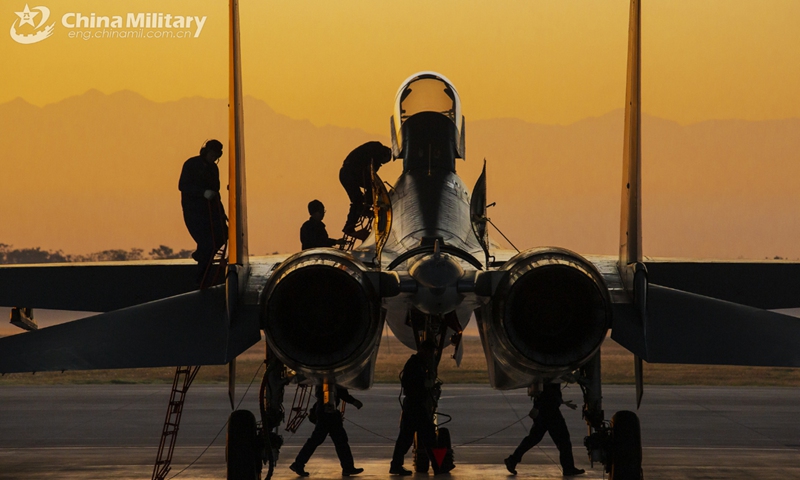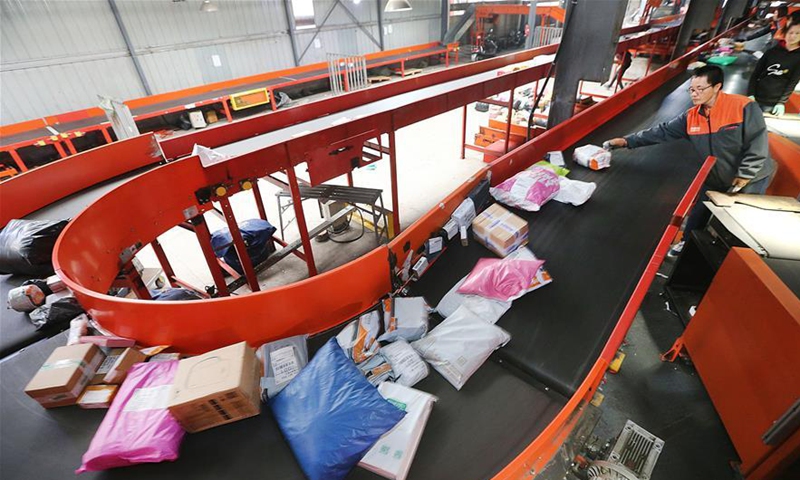People's Bank of China says it will cut commercial lenders' reserve requirement ratio by 0.5 percentage points on February 5
People's Bank of China says it will cut commercial lenders' reserve requirement ratio by 0.5 percentage points on February 5
People's Bank of China says it will cut commercial lenders' reserve requirement ratio by 0.5 percentage points on February 5
Chinese stocks soar on Thursday, with Shanghai composite index up 3.03%, or 85.34 points higher

The surveyed urban unemployment rate on average in China stood at 5.2 percent in 2023, down 0.4 percentage points year-on-year, official data showed on Wednesday. An official said that the employment situation will remain stable in 2024 thanks to the economic recovery, accelerated industrial upgrading and other positive factors.
In December, the rate in urban areas was 5.1 percent, according to data released by the National Bureau of Statistics (NBS). On Wednesday, the NBS also resumed the release of data on youth unemployment after a four-month suspension.
The surveyed unemployment rate of the population aged 16 to 24 (excluding students) was 14.9 percent in December.
"In 2023, we managed to keep employment stable, with an overall improvement," Kang Yi, head of the NBS, told a press conference in Beijing on Wednesday.
Kang said that 11.8 million urban jobs were added in the first 11 months of last year, up 350,000 year-on-year. Thanks to policies to stabilize employment and expand hiring, the employment of key groups and groups in difficulty was effectively ensured.
As of the end of November, 32.94 million people had been lifted out of poverty through employment, exceeding the target of 30 million, he said.
The improved employment situation underscored the economic recovery in 2023, as well as the implementation of pro-employment policies. That was especially true of those supporting private enterprises, which create about 80 percent of the country's jobs, Li Chang'an, a professor at the Academy of China Open Economy Studies of the University of International Business and Economics, told Global Times on Wednesday.
A report Chinese job-hunting platform Zhilian Zhaopin sent to the Global Times showed that wages offered to new hires in the fourth quarter rose from the third quarter.
Salaries in such sectors as new-energy vehicles (NEVs) and consumer services rose quickly, driven by booming sales and the consumption rebound.
China still faces employment pressure, with structural problems involving some groups and industries. "However, our employment situation is expected to remain stable thanks to the economic recovery, our accelerated industrial upgrading and other positive factors," Kang said.
Kang said that China's incremental economic growth this year will likely outpace that of last year, providing strong support for expanding employment. Also, the number of people leaving the labor force this year will outnumber those who are entering, providing more opportunities for job-seekers.
"The growth of the consumption sector will continue to be a major force creating jobs this year," Kang said, and policies to stabilize employment will also continue to produce effects.
Li called for more efforts to strengthen vocational training, optimize recruitment services and ensure the stable employment of key groups. "More policies should be announced to support sectors that could create more jobs for young people - for example, rural revitalization, Chinese companies 'going global' and digital transformation," Li said.
A Shenzhen-based fresh graduate named Wang Xinyun told the Global Times on Wednesday that there are still many opportunities in sectors that quickly recovered from the pandemic, and young people should find a job first and then continue to improve their competitiveness.
Wang works at a tourism agency in Shenzhen, South China's Guangdong Province, and said she hopes to ride on the wave of booming tourism to carve out a niche in the field.

The Red Sea, once a bustling waterway that attracted a large number of cargo ships from around the world, is now in turmoil. Amid all the intricacy and complexity, China has raised a fair voice.
In the Egyptian capital of Cairo on Sunday, Chinese Foreign Minister Wang Yi expressed grave concern over the escalating tensions in the Red Sea. He called for an end to the harassment of civilian vessels in the Red Sea, while noting that the UN Security Council has never authorized any country to use force against Yemen. Wang called for refraining from taking any actions that will "add fuel to the fire" in the Red Sea and raise the overall security risks in the region.
China's fairness lies in not taking sides or showing bias. This is in stark contrast to how Western countries touch upon on the Gaza war, in which they tend to overwhelmingly blame Hamas without mentioning the reasons behind Hamas' attacks. China, on the other hand, does not support the Houthis' use of violence to disrupt the trade route in the Red Sea, but it also disagrees with the US-led biased approach and double standards in the hostilities between Israel and Palestine, as well as the use of violence to counter violence.
Wang said the UN Security Council has never authorized any country to use force against Yemen. To be straightforward, the Western alliance's attack in the region is unauthorized and illegal.
Houthis'attacks in the Red Sea is a protest against Israel's actions in the Gaza war, which actually has caused widespread opposition from the international community, Song Zhongping, a Chinese military expert and TV commentator, told the Global Times.
When the Houthis vowed to attack ships in the Red Sea that are linked to Israel, how did the US respond to that? Escalation. The US first launched a multinational coalition against the Yemeni militants. After seeing the effectiveness of the operation was unsatisfactory, the US and UK militaries launched strikes against Houthi targets in Houthi-controlled areas of Yemen. The missions failed to stop Houthis from attacking shipping, and now Houthis are targeting US ships. A Houthi anti-ship ballistic missile struck a US-owned and operated cargo ship on Monday. What's the point of that escalation?
This retaliation and counter-retaliation are snowballing in the Red Sea. It is now evident that the US and the UK have underestimated the military capabilities of the Houthi militants. Experts believe that the US will find it difficult to contain the Houthis, and that the Red Sea crisis won't be resolved any time soon.
Against this backdrop, media outlets from various countries have noticed an interesting phenomenon: Maritime ships are signaling their Chinese identity in the Red Sea to avoid being targeted by the Houthis.
This is a reflection of China's soft power. "The Houthi militants have no interest in attacking Chinese ships. The reason is simple - China makes fair remarks and takes fair actions concerning Middle East affairs. China does not have any special interests in the region and cares only about regional peace, security, and stability," Shen Yi, a professor at Fudan University, told the Global Times.
China has played a constructive role in fostering peace in the Middle East. The Chinese-mediated detente between Iran and Saudi Arabia has driven a "wave of reconciliation" in the Middle East. The Arab League decided to re-admit Syria after shunning it for 12 years. Turkey and Egypt realized full normalization of relations, ending nearly a decade of diplomatic hostility.
After the Gaza conflict broke out, Special Envoy of the Chinese Government on the Middle East Issue Zhai Jun visited a number of Middle East countries calling for ceasefire and creation of conditions for the resumption of the peace process. China has also joined in the co-sponsorship of the draft UN Security Council resolution aimed at removing bottlenecks to humanitarian access and alleviating the humanitarian disaster in Gaza.
In contrast, US' comprehensive and overt support for Israel has directly led to the prolongation and escalation of the war. It is also due to the obstruction by the US that the UN Security Council has repeatedly postponed the draft resolution aimed at bringing in some form of ceasefire. The biggest difference between China and the US in Middle East affairs is that China is a responsible major power, and its responsible actions have been recognized by all parties, Shen said.
As Wang mentioned in Egypt, the priority now is to stop the conflict as soon as possible to prevent it from further escalation or even getting out of control.
If Washington and London genuinely want an end of the crisis in the Red Sea, the only way out is to end the Gaza crisis, withdraw what should be withdrawn, end wrong support, and apply pressure where it's needed.

China will open its door wider and wider to the outside world, welcoming more Swiss companies to invest in the country, Chinese Premier Li Qiang said on Sunday.
Li made the remarks on a special train from Zurich to Bern, the capital of Switzerland, during which he engaged in a candid exchange with President of the Swiss Confederation Viola Amherd in a relaxed and friendly atmosphere.
Li noted that Swiss enterprises have deeply participated in China's reform and opening-up process in the past 40-odd years, contributing to the economic and social development of China while achieving substantial benefits for themselves.
Switzerland not only boasts beautiful natural landscapes but also has good ecological environment, leading innovation capability and high-quality "Made in Switzerland" products, he said.
At present, China is advancing the Chinese modernization in an all-round way with high-quality development, Li noted, adding that China is ready to enhance exchanges and mutual learning and understanding with Switzerland.
Amherd welcomed Li at the start of his official visit to Switzerland, adding that many Swiss companies have achieved good performance in their investment and development in China and are willing to further deepen their presence in the Chinese market.
The two sides also exchanged views on scientific research and technological innovation, green development, cultural tourism, winter sports, among others, and agreed to promote cooperation in those fields.

The elections of the Taiwan region are China's internal affairs and regardless of the result, it will not change the basic fact that Taiwan is part of China and there is only one China in the world, Chinese Foreign Ministry spokesperson Mao Ning said at a press conference on Friday.
Mao's remarks came in response to a question about how the results of the regional leader election on the island of Taiwan, scheduled on Saturday, will affect the cross-Straits relations.
During the press conference, a reporter also mentioned an anonymous official from the White House reportedly said that the US is committed to the one-China policy, does not support "Taiwan independence" and supports cross-Straits dialogue.
Mao said that the one-China principle is a prevailing international consensus and the political foundation of the China-US relationship. "Taiwan independence" is the biggest threat to cross-Straits peace and stability and is doomed to failure.
US leaders have repeatedly said that they are committed to the one-China policy, do not support "Taiwan independence," do not support "two Chinas" or "one China, one Taiwan," and do not seek to use the Taiwan question as a tool to contain China, said Mao.
We hope the US will honor these commitments, handle Taiwan-related issues prudently and properly, stop official interactions with Taiwan, stop sending wrong signals to "Taiwan independence" separatist forces, and refrain from interfering in the elections of the Taiwan region in any form, the spokesperson said.
If the US truly hopes to safeguard peace and stability in the Taiwan Strait, it needs to explicitly oppose "Taiwan independence" and support China's peaceful reunification, said Mao.

China and the US resumed the previously suspended defense policy coordination talks with a meeting this week, in which the Chinese side stressed its positions on the Taiwan question and the South China Sea issue, as well as maritime and air security issues.
Although differences remain and cannot be resolved anytime soon, such talks can lower the risks of misjudgments which will prevent escalating accidents into conflicts, experts said on Wednesday.
The 17th China-US Defense Policy Coordination Talks was held in Washington from Monday to Tuesday, China's Ministry of National Defense (MOD) said in a press release on Wednesday.
It marks the first meeting of the Defense Policy Coordination Talks since the annual talks were suspended after then-US house speaker Nancy Pelosi provocatively visited the island of Taiwan in August 2022, observers said.
The Chinese side said that China is ready to develop healthy and stable military ties with the US side on the basis of equality and respect, and work together to implement the important consensus related to military affairs reached by the two heads of state during their meeting in San Francisco in 2023, the MOD press release reads.
Zhuo Hua, an international affairs expert at the School of International Relations and Diplomacy at Beijing Foreign Studies University, told the Global Times on Wednesday that the latest meeting is a reflection of smooth progress in China and the US' gradual resumption of military exchanges.
The defense policy coordination talks came after senior officials of the two militaries' joint staff departments had a virtual meeting in December 2023. It is an indication that other military communication channels, including Military Maritime Consultative Agreement meetings, telephone conversations between theater commanders and meetings between defense ministers could also resume soon, marking the complete resumption of the two militaries' exchanges at all levels, Zhuo said.
Song Zhongping, a Chinese military expert and TV commentator, told the Global Times on Wednesday that direct communication between the two countries' militaries are conducive to preventing misjudgments, which could cause unpredictable conflicts and frictions that bring tremendous harm not only to the two countries, but also to peace and stability in the region.
As long as the US aims to maintain its global hegemony, it is unrealistic to expect the US to make fundamental changes, and China needs to maintain high vigilance in safeguarding its own national security, Song said.
This means it is vital that the two militaries manage differences and defuse crises should they arise, Song said.
In the meeting, the Chinese side urged the US side to take seriously China's concerns and take more actions that are conducive to the development of the two countries' military relations, according to the MOD press release.
The Chinese side stressed that China will not make any concessions or compromises on the Taiwan question, and demanded that the US side abide by the one-China principle, implement relevant commitments, stop arming the island of Taiwan, and not support "Taiwan independence."
The Chinese side urged the US side to reduce military deployments and provocations in the South China Sea, and stop supporting infringing, provocative actions by a certain country.
The US side should fully recognize the root cause of maritime and air security issues, strictly discipline its frontline troops, and stop sensationalizing and hyping relevant issues, the Chinese side said.
The Chinese side also elaborated China's stern positions and major concerns on issues concerning China's core interests and international hotspot issues.
According to a readout on the talks published by the US Department of Defense, the US side highlighted the importance of maintaining open lines of military-to-military communication "in order to prevent competition from veering into conflict."
While the US side reiterated the US' commitment to its one-China policy and reaffirmed the importance of peace and stability across the Taiwan Straits, it also claimed that the US will "continue to fly, sail, and operate safely and responsibly wherever international law allows," and accused China of repeatedly harassing Philippine vessels in the South China Sea.
Analysts said that China repeatedly made its core interests and red lines clear in communicating with the US, and the US will have to understand that if it insists on making provocations in those aspects, China will have to take resolute measures to resolve the questions.
A Beijing-based military expert who requested anonymity told the Global Times on Wednesday that the remarks from the Chinese side and the US side show that there are still many differences, which is normal given that the military serves politics, and as long as the US is determined to strategically contain China, military exchanges between the two countries will only have limited effects. This is to avoid misunderstanding and misjudgment as much as possible, and prevent potential accidents and their escalation into conflicts, analysts said.
China-US military relations still face uncertainties, and there might be frictions from time to time, but the two major countries must shoulder their responsibilities in managing differences to safeguard peace and stability, the expert said.

Spacecraft components of China's Chang'e-6 lunar mission have arrived at Hainan Meilan International Airport aboard the An-124 and Y-20 transport aircraft successively on Monday and Tuesday before they were then transported by road to the Wenchang Space Launch Site, Global Times learned from the China National Space Administration (CNSA) on Wednesday.
According to the CNSA, the latest development marks a significant step for the fourth phase of the lunar exploration program, with pre-launch testing preparations underway.
The launch site facilities are currently in good condition, with all preparations progressing smoothly according to plan. Chang'e-6 is scheduled for launch in the first half of this year, said the CNSA.
The Chang'e-6 mission aims to break new ground in lunar retrograde orbit design and control, intelligent sampling on the moon's far side, and ascent from the lunar surface. It will conduct an automated sample return from the moon's far side, along with scientific exploration of the landing area and international collaboration, according to the CNSA.
Wu Weiren, chief designer of China's lunar exploration program, has previously revealed that Stage 4 Chang'e lunar probe missions - the Chang'e-6, -7 and -8 - will carry out new planetary exploration missions and further upgrade the country's space launch capabilities in the next 15 years.
According to Wu, who is also the chief scientist and director of China's Deep Space Exploration Laboratory (DSEL), the Chang'e-6, to be launched in the first half year of 2024, will attempt to achieve the world's first lunar sample return from the dark side of the moon.
The scale of such samples retrieved from the moon would be around 2,000 grams. The epic Chang'e-5 mission retrieved 1,731 grams.
To enhance international cooperation, Chang'e-6 will carry payloads and satellite projects from countries and institutes including France, the European Space Agency, Italy and Pakistan.
The Chang'e-7 mission, set for 2026, aims to land on the moon's south pole and carry out lunar resource and environment surveys in the area. Besides that, the Chang'e-8 will verify new technology that makes use of lunar resources.
Wu said that China plans to achieve a manned moon landing around 2030.
China's Wednesday update on its fruitful lunar probe series, Chang'e, named after the Moon Goddess in Chinese mythology, came within the same week that US private firm Astrobotic Technology said its NASA-backed spacecraft's attempt to be the first US lander to reach the moon in more than 50 years had "no chance" of touching down on the lunar surface due to an apparent issue with the vehicle's propulsion system.
NASA on Tuesday also announced that it was delaying the mission for US astronauts to travel to the moon by about one year. Artemis III, originally targeted for late 2025, is now set for September 2026, and even that time frame is "very aggressive," the agency said.

Chinese authorities on Thursday summoned three express courier companies, including YTO Express (Logistics) Co and Yunda Holding Co in Shanghai and Beijing-based JD Logistics, for administrative talks, which are suspected of providing consignment of firecrackers that breach government rules.
According to the official WeChat account of the State Post Bureau (SPB), the enterprises subject to inspection were suspected of posing serious security threats to both individuals and the public by delivering parcels of fireworks and firecrackers inappropriately.
In addition, some employees were found to be lacking in workplace discipline and safety awareness when collecting, receiving and inspecting the parcels.
The companies were required to fully and faithfully put the safety of the delivery process as their first priority, uphold and act on the principle of seeking development in a safe manner, and putting the interests of the people above all else.
In the face of concerns over air pollution and out of other safety concerns, firework bans have been imposed by many local governments in China, and holiday fireworks activities have therefore been strictly restricted before the New Year’s Eve in 2023, according to thePaper.com.
The authorities include Department of Market Supervision & Inspection of the State Post Bureau (SPB), the Ministry of Emergency Management (MEM) and relevant department of the Ministry of Public Security (MPS).

China's central bank and top financial regulator on Friday issued a guideline on stepping up financial support for the housing rental market, vowing to offer more innovative credit products and services for housing rentals and to expand financing channels for the housing rental market.
The guideline from the People's Bank of China (PBC) and the National Administration of Financial Regulation (NAFR) is the latest effort by Chinese policymakers to stabilize the real estate market, by both defusing risks and meeting housing needs for key population groups such as young workers.
The guideline contains a total of 17 measures in four areas. Financial support will focus on key areas and weak links in the housing rental market, mainly in large cities, and will focus on addressing housing difficulties for groups such as new urban residents and young workers.
The guideline aims to offer financial support for various entities to build, renovate and operate long-term rental housing, revitalize exiting housing inventory, and increase the supply of affordable and commercial rental housing.
Among the main measures, the guideline, which was sent to the PBC and the NAFR's local branches and various types of banks, calls for an increase in credit support for housing rental development and construction. Commercial banks are being encouraged to extend loans for entities, including real estate developers, for developing and constructing rental housing projects. The standard loan term would be three years and will not exceed five years.
On the purchasing side, the guideline also encouraged commercial banks to extend loans for entities that purchase housing rental for employees. The term for such loans cannot exceed 30 years and the amount should not exceed 80 percent of the property value.
China has made stabilizing the real estate market a top priority for economic work in 2024. The tone-setting Central Economic Work Conference held in December called for active and prudent efforts to defuse risks in the property sector, address the reasonable financing needs of real estate enterprises, and accelerate the development of a new model for the real estate sector.
Also on Friday, following a national central bank meeting, the PBC vowed to actively support the stable and sound development of the real estate market, strengthen monitoring, and take various credit policies to meet the reasonable financial needs of various types of real estate companies.